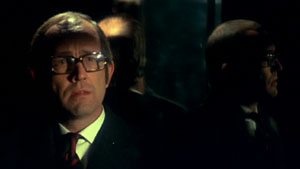Robert Elliot, a well-respected economist, is about to get a huge promotion in the form of advisor to the president. While his former girlfriend, reporter Jean Robertson, thinks he’s sold out, she doesn’t know the half of it. Up until now, Robert’s been working as a secret agent and doing things that definitely aren’t on the up and up. Due to his impending rise among the ranks, the four people that work under him need to be taken care of so they can’t reveal his criminal activities. Not wanting to get his hands dirty, Robert decides to manipulate all of them into killing one another. Surely this can’t go off without a hitch…can it?
 |
 |
Having not even heard of The Internecine Project before it arrived for review, I was pleasantly surprised with what a quality film about murder, deceit, and espionage this turned out to be. The film is a confusing affair for the first 25 or so minutes as faces and names of characters fly at you quickly and motivations and alliances are hard to keep track of. Once the core plot of the film starts to reveal itself however, things start to click into place and become very clever, offering more than one “A-ha!” moment. The film manages to create some great tension too, despite that the extent of Coburn’s action in the second-half amounts to sitting and waiting for telephones to ring. That probably has to do with how flawlessly the whole plan is set into motion; it’s all rather cunningly done, and while it may be a little far-fetched, it’s undoubtedly entertaining and fun to see how the events unfold.
 |
 |
The direction on hand is pretty subdued, letting the story and action do the talking, but there are a few slick, albeit tongue-in-cheek, techniques that pop up now and again, highlighted by some Mission Impossible inspired dramatic close-ups of all involved complete with their character’s name typed along the bottom of the screen. All of the actor’s go a great job in their parts, and while many may be more accustomed to the names of James Coburn and Ian Hendry, the real highlight is Harry Andrews, who plays a woman-hating, cat-hoarding maniac that doesn’t need anything but his bare hands to eliminate his target. The Internecine Project is much better than you’d expect out of a film that has seemingly fallen off the face of film history and is definitely worthy of any thriller fan’s attention. Scorpion Releasing keeps on doing their amazing work on presenting quality films that have been undeservingly shoved into a corner to collect dust, and offering them up with great quality and care. Presented in 1.85:1 anamorphic widescreen, the print used is in great shape, and while certain scenes can be a bit grainy and there are a couple instances of color discrepancies, there’s very little in the way of any damage and overall there’s not very much to complain about. The mono English track is free of any problems and sounds quite good. The big extra here is a 30-minute interview with writer Jonathan Lynn, who’s probably best known for directing Clue. He tells some interesting stories about working with Barry Levinson (not the one you’re probably thinking of), the changes that were made to his original script, and how he’d like to personally direct a modern version of the film, which I actually think isn’t so bad of an idea. Actress Lee Grant shows up in a very short interview where she basically just tells a story about not being able to sleep while working on the film. Lisa Coburn (James Coburn's daughter) provides an audio interview about her father, his legacy, and how much he loved working in film. Rounding out the extra features are trailers for this and other current and future Scorpion releases.
Please feel free to discuss "The Internecine Project" here, in our forums!